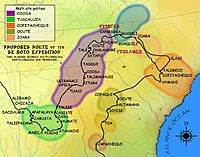Little Egypt (archaeological site) facts for kids
| Location | Murray County, Georgia, |
|---|---|
| Region | Murray County, Georgia |
| Coordinates | 34°35′58.49″N 84°40′48.76″W / 34.5995806°N 84.6802111°W |
| History | |
| Founded | 1300 CE |
| Abandoned | 1600 CE |
| Periods | Dallas Phase, Lamar Phase, Mouse Creek Phase |
| Cultures | South Appalachian Mississippian culture |
| Site notes | |
| Excavation dates | 1925, 1969 |
| Archaeologists | Warren K. Moorehead |
| Responsible body: private | |
The Little Egypt site (also known as 9 MU 102) was an important ancient village in Murray County, Georgia. It was located where the Coosawattee River and Talking Rock Creek meet. This site was once home to a large community of people from the Mississippian culture. They lived here between about 1300 and 1600 CE.
The Little Egypt site was special because it had three large platform mounds built by the people. These mounds were like big, flat-topped hills. They were probably used for important buildings or ceremonies. There was also a central open area called a plaza and a big village around it.
Sadly, this entire site was destroyed in 1972. It was covered when the Carters Dam was built to create Carters Lake. Before it was covered, archaeologists studied the site to learn about the people who lived there long ago. They found pottery and other clues that helped them understand the history of this ancient community.
Contents
Life at the Little Egypt Site
The Little Egypt site was a large village, covering about 12.5 acres (5 hectares). It was built on a flat area near the Coosawattee River. The village had three large platform mounds and a central open space called a plaza.
Two of the mounds were taller than 8 feet (2.5 meters). The main mound was built up in four different stages over many years. Each new stage might have shown a change in leadership, like when a chief passed power to their successor.
Around 1475 A.D., the Little Egypt site became the main city of a powerful chiefdom. A chiefdom is like a small kingdom ruled by a chief. This chiefdom controlled many other villages in the area.
The Coosa Chiefdom and European Contact

The Little Egypt site was the capital of the Coosa chiefdom. This was the chiefdom that the Spanish explorer Hernando de Soto and his expedition encountered in 1540.
When de Soto arrived, his writers recorded that the Coosa chiefdom had eight villages. Archaeologists have since found the remains of seven of these villages. Experts believe the Coosa chiefdom had a population of about 2,500 to 4,650 people.
The chief of Coosa was very powerful. He ruled over a much larger group of chiefdoms. This "paramount chiefdom" stretched for 400 miles along the Appalachian Mountains. It covered parts of northern Georgia, eastern Tennessee, and central Alabama. This larger group included about 50,000 people.
Uncovering the Past: Archaeological Digs
The Little Egypt site was excavated twice by archaeologists. The first dig was in 1925 by Warren K. Moorehead. The second, more detailed dig was in 1969 by David Hally from the University of Georgia.
Before these digs, the site had been damaged by farming and by water erosion from the nearby river. In later times, Native American groups like the Creeks and Cherokee lived in the general area. However, they did not live on the ancient mounds themselves.
During the 1969 excavation, Hally and his team dug several pits and trenches. They found two mounds and a village area. Mound A was about 9 feet (2.7 meters) tall, and Mound B was about 6 feet (1.8 meters) tall when they were excavated.
Archaeologists found many interesting things, including:
- Smudge pits: These were used to smoke deer hides.
- Ash layers: These contained pieces of food, showing what people ate. They found plant remains, especially acorns, and animal bones.
- Hearths: These were ancient fireplaces.
The animal bones found included fresh water mussel shells, fish, turtles, birds (especially turkey), deer, black bear, beaver, bobcat, opossum, raccoon, and squirrel. Not all types of bones were found everywhere. This suggests that certain foods might have been eaten by different groups of people, possibly showing a social order.
Artifacts and Discoveries
Many artifacts were found during the excavations. These are objects made by people long ago. Some of the artifacts included:
- Columella beads (made from parts of seashells)
- Cut and ground antler tools
- Bone awls (sharp tools made from bone)
- A shell mask (a carved shell worn as jewelry)
- Brass rings
- Fragments of Mississippian copper plates (thin pieces of copper with designs)
Archaeologists also found stone tools like rock flakes, blades, points, and bifaces. They discovered twenty different types of pottery pieces. These pottery styles belonged to different time periods, including Woodland, Woodstock, and Lamar designs.
The excavations showed that people lived at the Little Egypt site during several different time periods:
- Early and Middle Woodland periods: Pottery shards from these times were found.
- Woodstock period: More pottery shards and evidence of wall trenches (for buildings) were discovered.
- Little Egypt period: This period showed more pottery, at least one mound structure, and areas where people lived.
- Barnett period: This time period had many structures, trash piles (middens), and possibly two mounds with a large living area.


